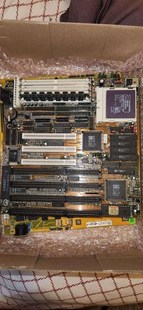First post, by carlostex
- Rank
- l33t
Roughly one month ago the VR on my LS486 rev D literally blew. Not only i heard a popping noise i saw smoke rising from VR area and suddenly i see the damn thing crack!
So i ordered LM317 and L7805 VR's from ebay. I desoldered the cracked VR from the board and tried to boot it with a 5V CPU. No matter what i tried the damn thing wouldn't boot. So i thought the 1000uf 10V capacitor that is near the VR was also dead. So i ordered same voltage same rating japanese capacitors. Yesterday i soldered both capacitor and the LM317 VR.
Board is ALIVE AGAIN!!! At least with 5V CPU's. With 3V no dice. So i checked all the tips of VR with multimeter and when i set the board to 3V CPU's the center tip is in fact delivering around 3.05V. I guess this is insufficient to power the 3.3V CPU's i tried. When i actually powerup, i can see the lights of the keyboard blinking, but there is no beeps, no POST, nothing.
Now i noticed that the original VR on board is marked as TIP107. So i google it and it does report as a power transistor instead of a voltage regulator.
I haven't tried the L7805 yet and i'm probably gonna try it tomorrow, but i've been wondering if i really do need a TIP107. As i don't understand these electronic thingies i hope someone can tell me the difference between them.
Waiting anxiously for the experts answers on my problem.
Thanks in advance

